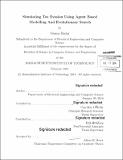Simulating tax evasion using agent based modelling And evolutionary search
Author(s)
Badar, Osama
DownloadFull printable version (5.437Mb)
Other Contributors
Massachusetts Institute of Technology. Department of Electrical Engineering and Computer Science.
Advisor
Una-May O'Reilly and Erik Hemberg.
Terms of use
Metadata
Show full item recordAbstract
We present a design and model for Simulating Co-Evolution of Tax and Evasion (SCOTE). The system performs agent based modeling of the tax ecosystem and searches for tax evasion strategies using a variant of a Genetic Algorithm with a grammar. Current methodologies and tools to detect, discover or recognize tax evasion are not sufficient. In recent years the tax gap, the aggregate sum of the difference between the tax owed in principle and tax paid in practice was calculated to exceed 450 billion dollars. Numerous tax evasion schemes have surfaced that perform seemingly legal transactions but once observed closely their sole purpose is to reduce tax liability. Moreover, these schemes are evolving with time. Whenever a scheme is detected and eliminated by fixing a loop hole in the tax code, others emerge to replace it and currently there is no systematic way to predict the emergence of these schemes. SCOTE allows us to encode tax evasion strategies into a searchable representation. SCOTE has three major components namely the Genetic Algorithm library(GA), the interpreter and the Parser. The GA encodes transaction plans into an integer representation and performs search over the transaction plans to find a scheme that produces the maximum tax gap. The Parser performs grammatical mapping of list of integers to a transaction plan.The interpreter models the tax ecosystem into a graph where the entities such as taxpayer and partnerships are nodes and the transactions between entities are the edges. Each entity has a portfolio of assets and the values of the assets are updated after a transaction. The interpreter runs a transaction plan generated by GA on the graph to produce the tax gap. We ran two experiments using two of the known tax evasion schemes namely "Son of Boss" and "iBOB" and we were able to detect the two schemes using SCOTE.
Description
Thesis: M. Eng., Massachusetts Institute of Technology, Department of Electrical Engineering and Computer Science, 2014. 7 Cataloged from PDF version of thesis. Includes bibliographical references (page 61).
Date issued
2014Department
Massachusetts Institute of Technology. Department of Electrical Engineering and Computer SciencePublisher
Massachusetts Institute of Technology
Keywords
Electrical Engineering and Computer Science.